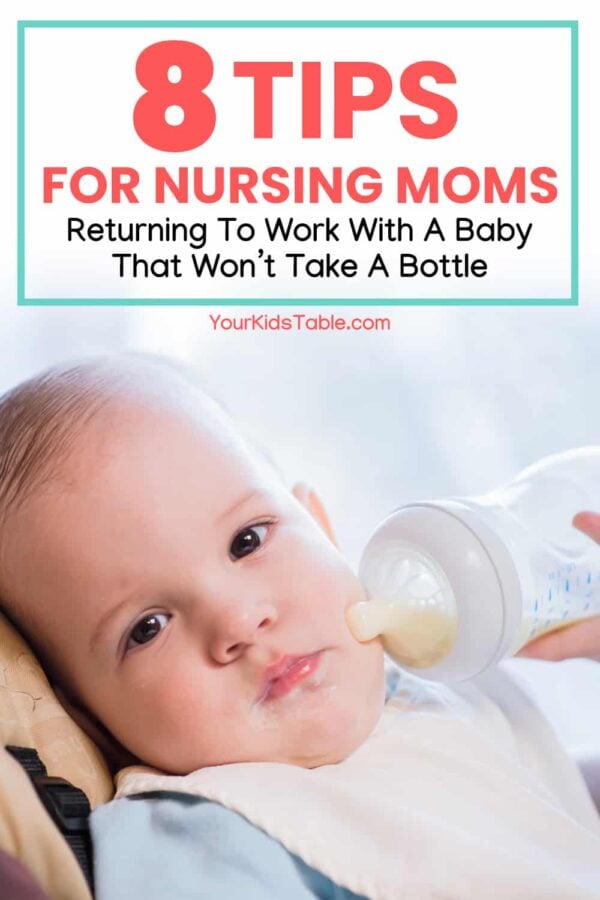Need your baby to take a bottle before you go back to work, try these 8 tips from a momma and OT to give you some peace of mind while you’re working!
When I picked my oldest son up from daycare for the first time, I heard words that had me spiraling into a panic….
“He cried most of the time you were gone, and he only took about 3-4 ounces of milk the entire day.”
I had been gone for a total of 11 hours. How was this possible?
I had worked so hard to establish breastfeeding that I had only given him a handful of bottles before it was time for him to head to daycare at 2.5 months. He had taken them for me. Not perfectly, but well enough I thought.
And here I was, going back to work with a baby who completely refused to take a bottle.
His caregiver and I tried and tried. Unfortunately, with very little success. This meant for me that he would drink very little during the day and stay up all night long nursing to make up for lost time.
I was completely exhausted! I wish I had known how to problem solve what was going on with him. But at the time, I didn’t.
Why is Your Breastfed Baby Refusing a Bottle?
There are a variety of reasons babies refuse to take the bottle. Understanding why your child is having difficulty is an important first step to helping them accept the bottle from another caregiver while you’re working.
Let’s look at 4 big reasons:
#1: Bottle Feeding is Different!
You may have heard before that it’s easier for a baby to latch to a bottle rather than breastfeed. This is absolutely true, for most babies. However, I’ve learned that this isn’t necessarily true for all babies with all types of bottles.
Breastfeeding is really individualized.
Many moms and babies struggle with it when they first start out. Over time, they figure out what works for them and sometimes they even come up with little ways to compensate for a poor latch or weak mouth muscles.
This can happen without you even knowing they’re doing it!
While bottle feeding is often easier, it’s still different. It requires slightly different skills, which can be hard for a baby to get used. This can be especially challenging if they’re tired, in an unknown place, or miss the smell of mom.
#2: Babies Have Sensory Needs!
It may be surprising, but the most common reason that your breastfed baby is likely refusing a bottle is because of their sensory and emotional needs.
In the world of occupational therapy, you often hear about the sensory and emotional needs of older kids who are struggling with sensory processing.
They fidget a lot or hate getting messy. We so often forget that babies have unique sensory and emotional needs too!
Some babies like to be held or swaddled a certain way or would prefer the lights dim. Other babies are more interested in bouncing constantly and seeing the world around them.
If you’re using expressed milk, the temperature is a little different than your baby is used to. It may be a little warmer or a little cooler. If you’re using formula, the taste is different as well!
As your baby gets older, they’re also becoming much more socially aware. You’ve likely learned what sensory input works well for them and what doesn’t. They also recognize your face and your smell.
When you leave your little one with a new caregiver, it can take time for them to get used to each other. That’s ok! But, it’s important to recognize that these could be challenges.
#3: Oral Motor Challenges That Go Unnoticed
Another reason that your baby may be struggling to bottle feed is because their oral motor skills don’t match up quite right with the bottle and technique being used.
Oral motor challenges can be difficult to identify.
If your little one had previous struggles with nursing (but has gotten the hang of it over time), you should still be on the lookout for the possibility of oral motor challenges.
We talk a lot about oral motor skills once a baby starts chewing, but they can also affect the way a baby is able to breast or bottle feed.
Oral motor skills have to do with how your baby uses the muscles in their mouth. The structure of their mouth can also play a part.
This is especially true if your baby was born before 37 weeks or if you notice that your baby lets their mouth hang open frequently.
Around 37 weeks gestation, babies start developing these handy sucking pads inside their cheeks. They help to stabilize the mouth, which is needed for adequate sucking. Without them, sucking can be just a little bit more difficult.
Your baby has also likely gotten used to your milk flow and the variation of it. It’s typically very slow to start, fast once let down happens, and then becomes more steady after that.
Although, this varies widely from mom to mom.
Babies have to coordinate their sucking, swallowing, and breathing in order to pull milk from the nipple into their mouth. This coordination can be challenging if the flow of the bottle nipple is too fast or if their jaw has some weakness.

#4: Underlying Medical Challenges That Shouldn’t Be Ignored
Underlying medical challenges aren’t the most common reason that babies struggle with moving from breastfeeding to bottle feeding, but they do happen.
If underlying medical challenges are the culprit, it’s very possible that you noticed some big challenges with breastfeeding as well.
The change in routine to bottle feeding can make them feel more pronounced.
Some of these challenges include, but are not limited to, allergies/intolerances, reflux or GERD, tongue or lip ties, or difficulties with coordinating swallowing. If you suspect any of these, it would be helpful to check in with your baby’s doctor.
Red Flags for Medical Challenges
- Coughing, turning head away and arching back
- Frequent audible gulping or gasping
- Heart shaped tongue
- Blood in stools
8 Tips for Nursing Moms Returning to Work With a Baby That Refuses the Bottle
If you know you’re going to return to work and need your baby to take a bottle, it can be helpful to start practicing a bottle as soon as breastfeeding is established.
However, if you’re just starting to leave your little one with a caregiver when they are over the age of 8-9 months, it may be helpful to skip the bottle and go straight to teaching them to use a straw or cup.
Use these tips to start practicing, or if you’re already back to work and WORRIED, you can begin implementing these right away to help your baby take the bottle while you’re gone:
1. Get them cozy and calm
Babies often eat the best when they are in the just right state of calm. This really goes back to their sensory needs. Their sensory systems aren’t all the way developed and a little extra support can go a long way.
Swaddling or using a zip up swaddle can be extremely helpful in encouraging a calm state as can closeness to a caregiver. Sometimes dimmed lights or a sound machine can be helpful tricks to try too.
2. Remind them of the comfort of mom
If your baby is used to nursing, they get a constant influx of your scent every time they eat. They may not be used to eating without it. Introducing a lovey or blanket that smells like you can be extremely helpful.
You can keep it on or near you for a few hours and it will start to smell like you. Starting to use it while you nurse can also give your little one more of an attachment to it.
Then, your baby’s caregiver is also able to use it while they feed them the bottle. It smells just like you!
3. Try to encourage naps so they don’t get over tired
This can be a bit of a tricky one for some babies who have higher sensory needs and like to stay awake. But, encouraging regular naps is helpful in ensuring that your little one doesn’t get overtired.
Once a baby gets overtired, it can become much more difficult for them to settle down enough to focus on feeding.
Sleep requirements change as a baby ages. But really young babies often need to be napping every 1.5-2 hours. This can be really surprising, as it may feel like all your baby does is eat and sleep for a while!

4. Gradually introduce formula
Younger babies don’t always seem to have as big of a problem with switching from breastmilk to formula and back again. But, if you’re just starting formula when your baby is older than 2-3 months, this might be something to consider.
Formula can be such a helpful tool for so many families. But it’s important to consider that it tastes different from breastmilk. If you’re introducing formula after breastfeeding for a while, your baby might notice the difference.
Gradually introducing formula can be really helpful. You can do this by using expressed breast milk in a bottle with just a tiny bit of formula mixed in. If your little one does well with that amount, then you can increase it by just a touch the next time.
This may seem tedious, but it can be really helpful in getting your little one used to the different flavor of formula.
5. Double check the way your baby is being fed (placement of nipple in their mouth, check seal)
Watch and listen to your baby closely when they’re drinking from a bottle. You can ask their caregiver to do this as well. If a baby isn’t quite used to a bottle, they may move the nipple to the side of their mouth or even under their tongue.
This can create a problem because then a seal doesn’t form around the nipple allowing them to pull fluid out. This can lead to your little one getting really frustrated quickly because they’re hungry and aren’t getting their meal quick enough.
You want to check that the nipple sits on top of their tongue and that there isn’t a gap between their lips and the nipple. If you hear a clicking sound, that means the seal is being broken.
6. Try a different nipple
Bottle nipples come in all different shapes, sizes, and flows. See our list of recommendations and a few other tips for bottle drinking!
More recently, there has been an increase in bottle nipples that look more like the shape of breasts, hoping to make the transition to bottle feeding easier.
Unfortunately, this doesn’t always work as it was intended. When a baby breastfeeds, the baby actually pulls their mom’s nipple into their mouth, elongating it while they’re drinking.
Once the mom’s breast is actually in their mouth, it’s actually more similar to the more narrow bottle nipples rather than the wider based bottle nipples.
Sticking with a more narrow nipple can be really helpful.
The flow is also something to consider. Unfortunately, there is no standard of flow across brands of nipples. Each brand grades flow differently. The chart in THIS STUDY can give you an idea of the variety.
It can be helpful to test out a few stage nipples to get a feel for the different flows.
If you notice your baby coughing or pulling away from the bottle, then it’s possible that the flow of the nipple is too fast and you may want to go down a level. It may be that their oral motor skills aren’t quite ready for a faster flow nipple.
If your little one is chewing on the bottle nipple or looks disinterested in the bottle while drinking, it may be that the flow isn’t fast enough. Another sign that you might want to try a faster flow nipple is if they suck furiously and then become really frustrated quickly.
They’re hungry and the milk isn’t coming out quickly enough for them!
7. Offer support and stabilization
Support and stabilization can be a really helpful tip if you think your baby might have a little bit of weakness or maybe was born on the earlier side.
Just like you may have figured out some techniques to make breastfeeding work, there are some things that can help your little one bottle feed.
If you notice that they take lots of breaks while drinking a bottle, you may consider giving them a little support under their chin and cheeks. You can do this by gently cupping your hands under their chin and placing a finger on each cheek.
If you’ve reduced the flow of the nipple and they still seem to be having trouble managing the amount of fluid, you can give them breaks by lightly tilting the bottle away from them briefly so they can catch their breath.

8. Seek Outside Help
If you’ve tried all of these suggestions, or your baby has any of the red flags listed, you should consider getting some outside help.
It can make all the difference!
You can talk to your child’s pediatrician to see if they have any recommendations specific to your area.
An occupational therapist, speech therapist, or a lactation consultant who has experience working with feeding babies would be the best person to help you. They can give you recommendations specific to your baby and what would best help them.
Are you just returning to work and struggling with introducing a bottle? Let us know in the comments! What has worked for you? What hasn’t?
More On Baby Development
Why Your Baby Should Be Putting Toys In Their Mouth
The Complete Guide For Breastfed Babies that Refuse Bottles
What You Need to Know About Your Baby Gagging
What to Do When Baby Won’t Eat Solid Food: 7 Simple Steps
Andrea Timler is a licensed occupational therapist and part of the Your Kid’s Table Team. She has over 7 years experience with expertise in development and feeding in babies, toddlers, and children. Andrea also has 4 kiddos of her own at home.

My baby was bottle fed for the first month of his life due to being premature (36 weeks) and having tongue tie.
We got him breastfeeding around a month old but continued giving him a bottle once a day. When he was 3 months old we didn’t give him a bottle for 5 days. Then the next bottle offering he refused. Still trying daily but he won’t accept breast milk or formula, from either myself or husband.
The bottle feeding is like he doesn’t know what to do anymore – plays with the teat in his mouth, moves his tongue round etc
He’s now 6.5 months old and I go back to work in 2.5. Starting to get a little worried about how he’ll manage.
Hi Katherine,
will he use a straw cup or sippy cup? Some kids as young as yours won’t take bottles but will drink milk from another cup. It can be really stressful when they won’t take a bottle, but this might be worth a try.
Best,
Laura
Your Kid’s Table team member
10pp baby is exclusively breastfed but we did introduce a bottle early on of pumped breast milk. My husband would give one bottle a day for bonding and also to give me a breAk. Starting a couple weeks ago she would fuss and cry quite a bit before taking the bottle from him. We use dr brown and the como bottles. She takes the bottle from me within a couple secs – doesn’t matter which bottle/nipple we use. (Usually slightly warmed milk with occasional room temp) I am returning to work in less than two months. Would like the bottle feeding to be more pleasurable for my husband and little one. We’ve tried me being in another room and also me being right next to my husband so she can see me.
Any tips? Continue to try daily? My husband works so max can only do 1-2 bottles a day but will be taking paternity leave when I go back to work.
Thanks!!
Hey Sarah,
Bottle feeding can be such a challenge! Since your little one was taking a bottle without a problem before, it sounds like she may have become a bit more aware. Keeping up with the feedings daily (1-2x works perfectly) and adding in something a lovey or something that smells like you might be helpful. Be sure to look at our Bottle Feeding article for some more ideas. Hang in there!
Best,
Andrea
Hi. Our BG is four and a half months old and never taken a bottle. We have tried three weeks of getting her to drink warm breast milk from the bottle. Sometimes wrapped in mom’s shirt. Not sure what to do. Based on the comments below we may have to grind it out for five or six weeks, and she just ends up hungry. Any suggestions bc mom wants to go back to work!
Hi there! It can be so tough! But yes, definitely keep trying and offering! I would try to make sure when you are providing the bottle that you give it to her in the same place that you normally breastfeed. I would make sure that it’s quiet so that she can focus on eating. You can also try to provide a pacifier for her during the day so she can get used to the different feel of the nipple, or even trying different bottle types/brands to see if she likes one more than another. You can also check out this post for some more tips! Hope that helps!
Best,
Kalyn
My second child refused to take a bottle at day care. He never did, but we were successful with getting him to drink out of a sippy cup instead. For us, the winning cup was the Nuk Learner Cup. Then, once he was old enough for solids, I would mix a bottle’s worth of breastmilk (I did 4 oz) with a little fruit puree and enough baby oat cereal to thicken it, and that worked for one of the feedings. He loved it and would gobble it right up.
Hey Kristen,
We’re so glad to hear that you guys found something that worked well for you and your son. It can be so tough to leave our little ones when we go to work, especially if they don’t easily take a bottle. Thanks for sharing your experience.
Best,
Andrea
How old was he when you started with the cup?
I went back to work at 4 weeks PP. we had given the baby 2 bottles prior to my return to work and he took them just fine. He took the bottle just fine while I was away at work from weeks 5-7 PP (the first bottle of the day was a little rough, but each feeding got easier). Fast forward to week 8 when I begin my maternity leave and I don’t give the bottle daily. Week 9 comes along and I leave the baby home with dad. The baby refuses to take the bottle and screams himself to sleep. What?!? He was fine 11 days ago! What had happened? We think it was just a fluke and don’t really do anything about it (no bottle feedings). Fast forward 2 more weeks (week 11) and I leave the baby with my mom. Same thing happens: he refuses the bottle and screams himself to sleep. What?!? Meanwhile we talked to his pediatrician at his 8 week appointment who suggests to starve him out for 24 hours (mom leaves and only offer the bottle when hungry). The pediatrician also says his suggestion is unpopular and says he will have lactation reach out. They call and give me some suggestions and check back via phone a week later. Still refusing the bottle. They bring us in and do a consultation, check for ties, etc. we end up being referred out to a food/speech therapist. Fast forward to 12 weeks PP and here we are for an evaluation with the food/speech therapist. No ties. No true issues. Chalked up to stubbornness and preference. We begin weekly sessions. We are 5 weeks deep and he is taking the bottle again after countless tears from mom and baby, daily oral exercises, and determination! We tried all different types of bottles- ended up using Dr. Browns. Hang in there mommas!
Hey Lucy,
Oh it sounds like you guys had such a tough time. Big hugs! That really is so hard on everyone. I’m so glad to hear that he’s back to taking the bottle again! Keep going with it even if you’re nursing most of the time. We’re also big fans of Dr. Browns bottles over here as well. Thanks so much for sharing you’re experience with other parents out there.
Best,
Andrea